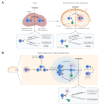B Cell Activation and Escape of Tolerance Checkpoints: Recent Insights from Studying Autoreactive B Cells
- PMID: 34068035
- PMCID: PMC8152463
- DOI: 10.3390/cells10051190
B Cell Activation and Escape of Tolerance Checkpoints: Recent Insights from Studying Autoreactive B Cells
Abstract
Autoreactive B cells are key drivers of pathogenic processes in autoimmune diseases by the production of autoantibodies, secretion of cytokines, and presentation of autoantigens to T cells. However, the mechanisms that underlie the development of autoreactive B cells are not well understood. Here, we review recent studies leveraging novel techniques to identify and characterize (auto)antigen-specific B cells. The insights gained from such studies pertaining to the mechanisms involved in the escape of tolerance checkpoints and the activation of autoreactive B cells are discussed. In addition, we briefly highlight potential therapeutic strategies to target and eliminate autoreactive B cells in autoimmune diseases.
Keywords: B cells; autoimmune diseases; autoreactive B cells; tolerance.
Conflict of interest statement
The authors declare no conflict of interest.
Figures



References
-
- Lerner A., Jeremias P., Matthias T. The World Incidence and Prevalence of Autoimmune Diseases is Increasing. Int. J. Celiac Dis. 2016;3:151–155. doi: 10.12691/ijcd-3-4-8. - DOI
Publication types
MeSH terms
Substances
Grants and funding
LinkOut - more resources
Full Text Sources
Medical

